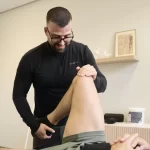What is pain?
Pain is a signal from the body that damage or injury is occurring, such as from a fall. It is an unpleasant sensation that can be stabbing, throbbing, nagging or cramping in nature. Besides an actual ''trauma'', pain can also be caused by overuse, inflammation (pressure/strain) or damage to the nervous system. Pain is thus actually a mechanism that protects us from severe(er) damage.
In the body, we distinguish two types of pain, acute pain and chronic pain. Acute pain is easy to recognise. This pain occurs after damage (a cut in your hand, for example). This type of pain is generally stabbing in nature and the site of the pain is clearly identifiable. Acute pain generally goes away fairly quickly. Chronic pain is pain that is present for at least three months. So we can no longer speak of tissue damage here.
Pain is measurable; we do this using an NRS (Numeric Rating Scale) or VAS (Visual Analog Scale). Here, we ask the patient to give a score of 0-10 (NRS) or 0-100 (VAS) to provide insight into the amount of pain experienced. This data can be used evaluatively and play a role in choosing the right treatment method.

Cushioning pain
Despite that pain feeling is very important, we also sometimes want to dampen pain. Fortunately, the body has several ways to dampen pain. For this, we can use medication such as paracetamol or NSAIDs, but also interventions such as dry-needling, TENS/shockwave, relaxation therapy, heat/cold, massage, manipulations, exercise and rest. All these ways of attenuating pain ensure that less pain is experienced by making the body less sensitive to pain stimuli.
What is muscle pain?
Muscle pain, as the name suggests, is pain in the muscles. We distinguish two forms of muscle pain, namely early or late muscle pain. Early muscle pain occurs just after exercise and is caused by exhaustion and acidification of the muscles. Late muscle soreness occurs 24/48 hours after exercise and is caused by hairline cracks in the muscle that have occurred due to the requested strain. With muscle pain, you often suffer from a nagging stiff feeling in a particular muscle (group). So muscle pain generally occurs after sport or another intensive activity and is a normal reaction of the body to the load placed on it. Muscle pain is therefore clearly different from 'real' pain in this respect.
Rehabilitation and pain
When you visit a physiotherapist the cause often lies in experiencing pain. Something is bothering you and you may be restricted in your daily activities. Whether this is after a operation, after trauma (fall, sprain o.i.d.) or due to complaints that arose for no apparent reason, one thing is certain, you are suffering. During treatment from a physiotherapist, you may experience pain because a certain exercise or technique used by the therapist complaints provokes. Sometimes this is necessary to achieve the intended result. There is just a caveat to this. Experiencing mild pain/complaints during treatment is generally considered acceptable up to a patient-specified NRS score of 2-3. Of course, there are exceptions to this.
Physiotherapists often advise that even during the rehabilitation keep moving, as this promotes recovery. Thus, pain may also be experienced during daily activities, sometimes exceeding an NRS score 3. Do not be alarmed by this. It is not a bad thing to experience more pain feel, this generally has no effect on recovery. However, it is important to make sure that this does not happen too often. So try to modify or temporarily avoid movements and activities that cause a lot of symptoms. Your physiotherapist can advise you well on this.
Besides pain during treatment, it can also happen that a treatment results in an after-reaction. By an after-reaction, we mean the temporary increase in the experienced burden/pain/restriction due to the stimuli given to the body during physiotherapy. For example, a patient with neck pain suffer less after a treatment, but experience more pain a few hours later. Sometimes this even results in a feeling of numbness. This is a normal reaction of the body to the given stimuli. However, we do like to see the after-reaction diminish within 24 hours.

